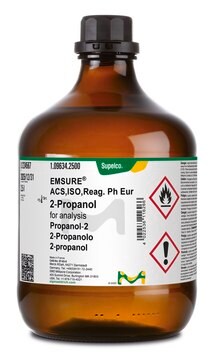320048
2-Methyl-1-propanol
ACS reagent, ≥99.0%
Sinónimos:
Isobutanol, Isobutyl alcohol
About This Item
Productos recomendados
grado
ACS reagent
Nivel de calidad
densidad de vapor
2.55 (vs air)
presión de vapor
8 mmHg ( 20 °C)
8.8 mmHg ( 0 °C)
Análisis
≥99.0%
formulario
liquid
temp. de autoignición
801 °F
lim. expl.
10.6 %
impurezas
≤0.0005 meq/g Titr. acid
≤0.01% butyraldehyde
≤0.02% 2-butanone
≤0.1% water
residuo de evap.
≤0.001%
color
APHA: ≤10
índice de refracción
n20/D 1.396 (lit.)
bp
108 °C (lit.)
mp
−108 °C (lit.)
densidad
0.803 g/mL at 25 °C (lit.)
cadena SMILES
CC(C)CO
InChI
1S/C4H10O/c1-4(2)3-5/h4-5H,3H2,1-2H3
Clave InChI
ZXEKIIBDNHEJCQ-UHFFFAOYSA-N
¿Está buscando productos similares? Visita Guía de comparación de productos
Categorías relacionadas
Palabra de señalización
Danger
Frases de peligro
Consejos de prudencia
Clasificaciones de peligro
Eye Dam. 1 - Flam. Liq. 3 - Skin Irrit. 2 - STOT SE 3
Órganos de actuación
Central nervous system, Respiratory system
Código de clase de almacenamiento
3 - Flammable liquids
Clase de riesgo para el agua (WGK)
WGK 1
Punto de inflamabilidad (°F)
82.4 °F - closed cup
Punto de inflamabilidad (°C)
28 °C - closed cup
Certificados de análisis (COA)
Busque Certificados de análisis (COA) introduciendo el número de lote del producto. Los números de lote se encuentran en la etiqueta del producto después de las palabras «Lot» o «Batch»
¿Ya tiene este producto?
Encuentre la documentación para los productos que ha comprado recientemente en la Biblioteca de documentos.
Los clientes también vieron
Nuestro equipo de científicos tiene experiencia en todas las áreas de investigación: Ciencias de la vida, Ciencia de los materiales, Síntesis química, Cromatografía, Analítica y muchas otras.
Póngase en contacto con el Servicio técnico












